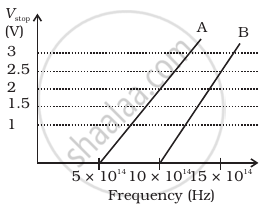Advertisements
Advertisements
प्रश्न
A student performs an experiment on photoelectric effect, using two materials A and B. A plot of Vstop vs ν is given in Figure.

- Which material A or B has a higher work function?
- Given the electric charge of an electron = 1.6 × 10–19 C, find the value of h obtained from the experiment for both A and B.
Comment on whether it is consistent with Einstein’s theory:
उत्तर
Threshold frequency (no): The minimum frequency of incident radiations, required to eject the electron from the metal surface is defined as the threshold frequency.
If incident frequency n < n0 ⇒ No photoelectron emission.
For most metals, the threshold frequency is in the ultraviolet (corresponding to wavelengths between 200 and 300 nm), but for potassium and caesium oxides it is in the visible spectrum (A between 400 and 700 nm).
Here we are given the threshold frequency of A
i. vOA = 5 × 1014 Hz and
For B, vOB = 10 × 014 Hz
We know that
Work function, `phi = hv_0` or `phi_0 ∝ v_0`
⇒ `phi_0 ∝ v_0`
So, `phi_(OA)/phi_(OB) = (5 xx 10^14)/(10 xx 10^14) < 1`
⇒ `phi_(OA) < phi_(OB)`
Thus, work function of B is higher than A.
ii. For metal A, slope = `h/e = 2/(10 - 15)10^14`
or `h = (2e)/(5 xx 10^14) = (2 xx 1.6 xx 10^-19)/(5 xx 10^14)`
= `6.4 xx 10^-34` Js
For metal B, sloe = `h/e = 2.5/((15 - 10)10^14`
or `h = (2.5 xx e)/(5 xx 10^14) = (2.5 xx 1.6 xx 10^-19)/(5 xx 10^14)`
= 8 × 10–34 Js
Since the value of h from the experiment for metals A and B is different. Hence, the experiment is not consistent with the theory.
APPEARS IN
संबंधित प्रश्न
Light of wavelength 488 nm is produced by an argon laser which is used in the photoelectric effect. When light from this spectral line is incident on the emitter, the stopping (cut-off) potential of photoelectrons is 0.38 V. Find the work function of the material from which the emitter is made.
Plot a graph showing the variation of photoelectric current with collector plate potential at a given frequency but for two different intensities I1 and I2, where I2 > I1.
point out any two characteristic properties of photons on which Einstein’s photoelectric equation is based ?
The frequency and intensity of a light source are doubled. Consider the following statements.
(A) The saturation photocurrent remains almost the same.
(B) The maximum kinetic energy of the photoelectrons is doubled.
A monochromatic light source of intensity 5 mW emits 8 × 1015 photons per second. This light ejects photoelectrons from a metal surface. The stopping potential for this setup is 2.0 V. Calculate the work function of the metal.
(Use h = 6.63 × 10-34J-s = 4.14 × 10-15 eV-s, c = 3 × 108 m/s and me = 9.1 × 10-31kg)
How does one explain the emission of electrons from a photosensitive surface with the help of Einstein’s photoelectric equation?
Use Einstein's photoelectric equation to show how from this graph,
(i) Threshold frequency, and
(ii) Planck's constant can be determined.
The wavelength of a photon needed to remove a proton from a nucleus which is bound to the nucleus with 1 MeV energy is nearly ______.
- In the explanation of photo electric effect, we assume one photon of frequency ν collides with an electron and transfers its energy. This leads to the equation for the maximum energy Emax of the emitted electron as Emax = hν – φ0 where φ0 is the work function of the metal. If an electron absorbs 2 photons (each of frequency ν) what will be the maximum energy for the emitted electron?
- Why is this fact (two photon absorption) not taken into consideration in our discussion of the stopping potential?
Radiation of frequency 1015 Hz is incident on three photosensitive surfaces A, B and C. Following observations are recorded:
Surface A: no photoemission occurs
Surface B: photoemission occurs but the photoelectrons have zero kinetic energy.
Surface C: photo emission occurs and photoelectrons have some kinetic energy.
Using Einstein’s photo-electric equation, explain the three observations.
